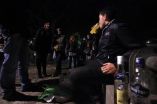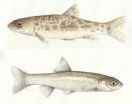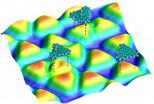Study points to window of opportunity for successful autism therapy
2010-11-12
(Press-News.org) "The biggest surprise to me was that we could rescue the autistic phenotype [in the human cells] to something close to normal," said Alysson Muotri of the University of California San Diego.
The researchers made the discovery by first transforming adult cells taken from patients with Rett Syndrome into induced pluripotent stem cells (iPS cells) using an established cocktail. iPS cells look and act very much like embryonic stem cells.
Those stem cells were able to form functional neurons in cell culture. However, neurons derived from Rett Syndrome patients exhibited some abnormalities when compared to those derived in the same way from healthy individuals.
The first thing the researchers noticed was that the cells were smaller than healthy neurons. They also had fewer synapses and displayed other signs of a failure to communicate properly, including altered calcium signaling and electrophysiological defects.
When the cells were treated with drugs that had shown promise for correcting autism symptoms in mice, those abnormalities were reversed. In fact, depending on the dose, Muotri said it appeared that the cellular defects could actually be "overcorrected."
The findings are especially notable because symptoms of Rett Syndrome typically don't set in until children are 6 to 18 months old, suggesting that the gene responsible isn't essential for early wiring of the nervous system, Muotri explained. The fact that newborn neurons derived in the laboratory already show signs of the disease suggests that there may still be underlying aberrations at the earliest stages of development, and that may have important clinical implications.
"Our data provide evidence of an unexplored developmental window, before disease onset, in Rett syndrome where potential therapies could be successfully employed," the researchers write.
Muotri says there is a need to search for better, more specific drugs than the ones applied in the study. That will require the development of methods to create iPS cells from human cells in large quantities, allowing for high-throughput screens for drug candidates.
His team is now working to derive iPS cells and neurons from children with sporadic autism, in which the causes are completely unknown. He suspects that at least some of their cells will show something similar to what has been observed in the case of Rett syndrome.
More generally, Muotri says he hopes that as this study and others shed more light on the biology of autism and other neuropsychiatric diseases, it will help to lift the stigma that is sometimes associated with them.
"There is a real, basic biology behind these diseases," he said. "We can see it in a culture dish."
INFORMATION: END
ELSE PRESS RELEASES FROM THIS DATE:
2010-11-12
They show that one of those genes in particular has a long evolutionary history, as evidenced by the fact that it plays a role in pain sensing in flies, mice and humans. At least in mice, the newly described gene is also linked to a condition known in humans as synesthesia, in which one sensory experience triggers the perception of another sense.
"We found lots of new genes and pathways that have never been implicated in pain before," said Josef Penninger of the Institute of Molecular Biotechnology of the Austrian Academy of Sciences.
"From a helicopter view, this ...
2010-11-12
Night-time violence among young Spaniards is becoming ever more common, according to a research study carried out by the European Institute of Studies on Prevention. The study shows that 5.2% of young people carry weapons when they go out at night, 11.6% have been attacked or threatened, and 23% have got into a fight at some time.
"Reports about young people being attacked or injured in fights when they go out at night are becoming increasingly common", Amador Calafat, lead author of the study and a researcher at the European Institute of Studies on Prevention (IREFREA), ...
2010-11-12
An international team led by the Forest Technology Centre of Catalonia has carried out the first large-scale study of the threats facing freshwater fish in the Mediterranean basin. Invasive species, along with over-exploitation of water resources, are the most important pressures, and those that expose fish to the greatest risk of extinction.
"The continental fish of the Mediterranean basin are one of the most threatened biological groups in the world", Miguel Clavero, lead author of the study and a researcher from the Landscape Ecology Group of the Forest Technology ...
2010-11-12
After four years of conducting intensive calculations in the supercomputer MareNostrum at the Barcelona Supercomputing Center, scientists headed by Modesto Orozco at the Institute for Research in Biomedicine (IRB Barcelona) have presented the world's largest data base on protein motions. Called MoDEL, this new database holds more than 1,700 proteins and is partially accessible through Internet to researchers worldwide. MoDEL has been developed to study the basic biology of proteins and to accelerate and facilitate the design of new pharmaceutical agents.
"Nowadays we ...
2010-11-12
Now that the 2010 election is over, here is something to consider for the 2012 race: If you want to fatten your company's profits, contribute to a political campaign.
A study by two College of Business Administration professors at the University of Tennessee, Knoxville, found that when firms engage in corporate political activities, such as lobbying and making campaign contributions, they enjoy about 20 percent higher performance. The study, by Russell Crook and David Woehr, along with Sean Lux of the University of South Florida, entitled "Mixing Business with Politics: ...
2010-11-12
Both the bully and the victim's individual characteristics, rather than the wider social environment, explain why bullying occurs, according to Swedish teenagers. The new study, by Dr. Robert Thornberg and Sven Knutsen from Linköping University in Sweden, also shows that 42 percent of teenagers blamed the victim for the bullying. The study is published online in Springer's journal, Child & Youth Care Forum.
In one of the rare studies investigating young people's views on why bullying takes place in school, Thornberg and Knutsen explored how teenagers explain bullying ...
2010-11-12
Electronic components are getting smaller and smaller, with microelectronic components gradually being replaced by nanoelectronic ones. On nanoscale dimensions, silicon, which is at the present stage the most commonly used material in semiconductor technology, reaches however a limit, preventing further miniaturization and technological progress. New electronic materials are therefore in great demand. Due to its outstanding electronic properties, graphene, a two-dimensional carbon network, is considered as a possible replacement. However, several obstacles must be overcome ...
2010-11-12
Fear arises in the almond-shaped brain structure known as the amygdala. It is the amygdala which processes the strange noise, shadowy figure or scary face and not only triggers palpitations or nausea but can also cause us to flee or freeze. That much has long been known about the function of this part of the brain. What remains largely unclear, however, is precisely how fear develops, and which of the countless neurons in the amygdaloid region are involved in this process. But finding answers to these questions is vital for those who wish to improve the quality of life ...
2010-11-12
Spanish and American researchers have conducted a mineralogical and chemical analysis to ascertain the origin of "terra rossa" soil in the Mediterranean. The results of the study reveal that mineral dust from the African regions of the Sahara and Sahel, which emit between 600 and 700 tonnes of dust a year, brought about the reddish soil in Mediterranean regions such as Mallorca and Sardinia between 12,000 and 25,000 years ago.
"The first hint of the relationship between African dust and certain soils in the region of the Mediterranean is their reddish or reddish-brown ...
2010-11-12
MAYWOOD, Ill. -- Alcohol does much more harm to the body than just damaging the liver. Drinking also can weaken the immune system, slow healing, impair bone formation, increase the risk of HIV transmission and hinder recovery from burns, trauma, bleeding and surgery.
Researchers released the latest findings on such negative effects of alcohol during a meeting Nov. 19 of the Alcohol and Immunology Research Interest Group, held at Loyola University Medical Center.
At Loyola, about 50 faculty members, technicians, post-doctoral fellows and students are conducting alcohol ...
LAST 30 PRESS RELEASES:
[Press-News.org] Study points to window of opportunity for successful autism therapy



